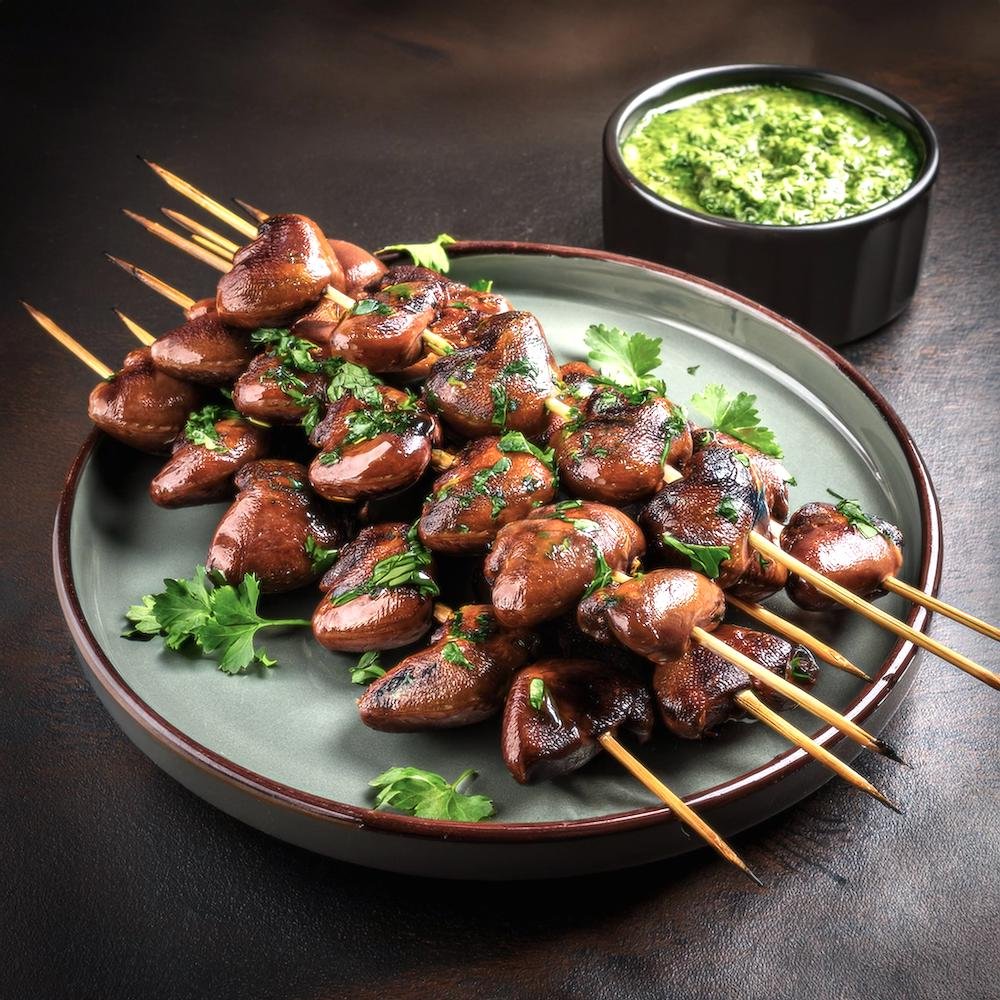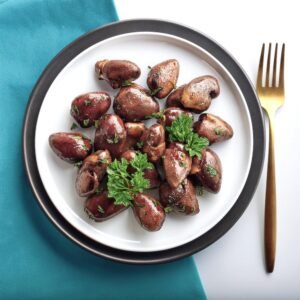What does a chicken heart taste like? Chicken hearts are a culinary delight enjoyed in many cultures around the world. Known for their unique flavor and tender texture, these small, nutrient-packed organs are a versatile ingredient that can elevate any meal. The chicken heart taste is often described as rich and savory, making it an appealing option for adventurous eaters and food lovers alike. Whether grilled, sautéed, or braised, the chicken heart taste offers a satisfying experience that pairs beautifully with a variety of seasonings and cooking styles.
In this article, we’ll explore the flavor and texture of chicken hearts, popular cooking techniques, and dishes that highlight their delicious potential. If you’ve ever wondered what chicken hearts taste like, read on to discover why they’re a cherished delicacy in global cuisines.
Flavor Profile of Chicken Hearts
Chicken hearts have a distinct taste that sets them apart from other cuts of chicken. Here’s a breakdown of their flavor:
1. Mild and Savory
- Chicken hearts have a mild, savory flavor that is often compared to dark meat chicken.
- Their taste is less intense than other organ meats, such as liver, making them more approachable for first-timers.
2. Slightly Gamey Undertone
- A subtle, gamey flavor adds depth to chicken hearts, especially when prepared with minimal seasoning.
- This unique characteristic enhances their appeal, particularly in rustic or traditional dishes.
3. Absorbent to Flavors
- Chicken hearts act like a sponge, absorbing marinades, spices, and sauces beautifully.
- Their flavor can be transformed entirely depending on the seasonings used, ranging from smoky barbecue to tangy Asian glazes.
4. Comparisons to Other Meats
- Like Chicken Thighs: Their flavor resembles the richness of chicken thighs but with a slightly firmer bite.
- Different from Gizzards: Unlike gizzards, which are tougher and have a more pronounced taste, chicken hearts are tender with a milder profile.
Pro Tip: Enhancing the Flavor
- Pair chicken hearts with bold seasonings like garlic, paprika, cumin, or soy-based marinades to complement their natural taste.
- Add a splash of acidity, such as lemon juice or vinegar, to brighten their flavor.
Texture of Chicken Hearts
The texture of chicken hearts is just as distinctive as their flavor. When prepared correctly, they offer a satisfying bite that pairs well with a variety of dishes. Here’s what to expect:
1. Tender Yet Firm
- Chicken hearts are naturally tender with a slight firmness, giving them a pleasing chew.
- This texture is similar to well-cooked dark chicken meat, offering a balance between softness and structure.
2. Slightly Chewy
- The chewiness of chicken hearts is subtle and not overly tough, making them enjoyable for most palates.
- This texture is especially appreciated when hearts are cooked on skewers or stir-fried, as it adds to their appeal.
3. How Cooking Affects Texture
Cooked Properly
- Quick cooking methods, like grilling or stir-frying, preserve the hearts’ tenderness and juicy interior.
- Braising them slowly in a flavorful liquid results in a melt-in-your-mouth texture.
Overcooking
- Overcooked chicken hearts can become rubbery and tough, detracting from their overall enjoyment.
- To avoid this, monitor cooking times carefully and aim for an internal temperature of 165°F (74°C).
4. Textural Contrast in Dishes
- The slight firmness of chicken hearts contrasts well with soft accompaniments like mashed potatoes, creamy sauces, or stewed vegetables.
- In dishes like stir-fries or grilled skewers, their chewiness balances the crunch of fresh vegetables or crispy coatings.
Pro Tip: Achieving the Perfect Texture
- Marinate chicken hearts before cooking to tenderize them further and enhance their flavor.
- Use high heat for a short period when grilling or pan-frying to create a golden exterior while keeping the inside tender.
Cooking Techniques That Enhance Flavor
Chicken hearts are incredibly versatile and can be prepared using various cooking techniques to bring out their best flavor and texture. Each method highlights different aspects of this delicacy, making it suitable for a wide range of dishes.
1. Grilling and Broiling
Why It Works
- Grilling and broiling impart a smoky, charred flavor to chicken hearts, enhancing their natural richness.
- These high-heat methods also caramelize the exterior, creating a crisp surface while keeping the inside tender.
How to Do It
- Marinate the chicken hearts in olive oil, garlic, smoked paprika, and lemon juice for at least 30 minutes.
- Skewer the hearts and grill over medium-high heat, or place them under the broiler.
- Cook for 2–3 minutes per side until slightly charred and cooked through.
2. Stir-Frying and Sautéing
Why It Works
- Quick cooking over high heat preserves the tender texture of chicken hearts and allows them to soak up flavorful sauces.
- This method is perfect for creating vibrant, balanced dishes.
How to Do It
- Heat sesame oil or olive oil in a wok or skillet over high heat.
- Add chicken hearts and stir-fry for 3–5 minutes, seasoning with soy sauce, ginger, garlic, and chili paste.
- Toss in vegetables like bell peppers, snap peas, or onions for a complete meal.
3. Braising
Why It Works
- Slow cooking in a savory liquid results in tender, melt-in-your-mouth chicken hearts.
- Braising allows the hearts to absorb the flavors of the broth, herbs, and spices.
How to Do It
- Sear chicken hearts in a pan with olive oil until lightly browned.
- Add aromatics like onions, garlic, thyme, and rosemary.
- Pour in chicken broth, white wine, or tomato sauce, and simmer gently for 20–30 minutes.
4. Roasting
Why It Works
- Roasting chicken hearts in the oven produces a crispy exterior and a juicy interior.
- It’s a convenient, hands-off method that works well with bold seasonings.
How to Do It
- Toss chicken hearts with olive oil, salt, pepper, and spices like cumin or smoked paprika.
- Spread them on a baking sheet and roast at 400°F (200°C) for 15–20 minutes, turning halfway through.
- Serve with a dipping sauce or as a protein-packed snack.
5. Frying
Why It Works
- Frying adds a crispy coating to chicken hearts, making them an irresistible appetizer or side dish.
- It’s a fun way to enjoy chicken hearts with a golden, crunchy texture.
How to Do It
- Soak chicken hearts in buttermilk to tenderize.
- Coat in a seasoned flour mixture (paprika, garlic powder, salt, and pepper).
- Fry in hot oil for 3–4 minutes until golden brown and crispy.
Pro Tip: Experiment with Flavors
- For grilling or roasting, use spice blends like Cajun seasoning or garam masala.
- In stir-fries or braises, incorporate ingredients like soy sauce, miso, or coconut milk for an international twist.
Popular Dishes Featuring Chicken Hearts
Chicken hearts are a beloved ingredient in cuisines worldwide, celebrated for their unique flavor and versatility. The chicken heart taste adds a rich and savory depth to these dishes, making them a standout choice in various culinary traditions. Here are some popular dishes that showcase the delicious potential of chicken hearts:
1. Brazilian Grilled Chicken Hearts
Description
Known as “Coraçãozinho” in Brazil, grilled chicken hearts are a staple at churrasco (Brazilian barbecue). Skewered and cooked over an open flame, they’re tender, smoky, and bursting with flavor.
How It’s Made
- Marinate chicken hearts in olive oil, garlic, smoked paprika, and lime juice.
- Skewer and grill over medium-high heat for 2–3 minutes per side.
- Serve with chimichurri sauce or farofa (toasted cassava flour).
2. Japanese Yakitori Chicken Hearts
Description
In Japan, chicken hearts, or “Hatsu,” are a popular yakitori skewer option served in izakayas (pubs). They’re grilled over charcoal and basted with a tare sauce made of soy sauce, mirin, and sake.
How It’s Made
- Thread chicken hearts onto bamboo skewers.
- Grill over high heat, brushing with tare sauce every few minutes.
- Serve hot, garnished with chopped green onions.
3. Stewed Chicken Hearts (Eastern European Style)
Description
Chicken hearts are a common ingredient in Eastern European stews and soups. Simmered with vegetables, herbs, and broth, they create a hearty and comforting dish.
How It’s Made
- Sear chicken hearts in a pan with onions and garlic.
- Add carrots, potatoes, and chicken broth. Season with thyme, paprika, and bay leaves.
- Simmer for 30 minutes until the hearts and vegetables are tender. Serve with crusty bread.
4. Southeast Asian Chicken Heart Stir-Fry
Description
Chicken hearts are a favorite in Southeast Asian street food. They’re stir-fried with bold flavors like garlic, ginger, chili, and soy sauce for a quick and savory dish.
How It’s Made
- Heat sesame oil in a wok and sauté minced garlic and ginger.
- Add chicken hearts and cook for 3–5 minutes until browned.
- Toss in soy sauce, oyster sauce, and chili paste. Add bell peppers or snap peas for crunch.
5. Crispy Fried Chicken Hearts
Description
Crispy fried chicken hearts are a fun, bite-sized snack or appetizer. The crunchy coating contrasts beautifully with their tender interior, making them a crowd-pleaser.
How It’s Made
- Soak chicken hearts in buttermilk, then dredge in seasoned flour.
- Fry in hot oil for 3–4 minutes until golden brown.
- Serve with ranch dressing, spicy aioli, or hot sauce.
6. Mediterranean Braised Chicken Hearts
Description
This slow-cooked dish features chicken hearts simmered in a rich tomato and herb sauce, paired with Mediterranean spices like cumin, coriander, and parsley.
How It’s Made
- Brown chicken hearts in olive oil, then remove from the pan.
- Sauté onions, garlic, and tomatoes. Add cumin, coriander, and chicken broth.
- Return the hearts to the pan and simmer for 20–30 minutes. Serve with couscous or rice.
Pro Tip: Make Them Your Own
Many of these dishes can be adapted to your tastes by changing the seasonings or accompaniments. For example, add a creamy yogurt sauce to Mediterranean dishes or experiment with spicy marinades for grilling.
Why Try Chicken Hearts?
Chicken hearts are a hidden gem in the culinary world. Their unique flavor, nutritional value, and versatility make them a fantastic ingredient to explore. Here are some compelling reasons to give chicken hearts a try:
1. Nutritional Benefits
- High in Protein: Chicken hearts are a great source of lean protein, which supports muscle growth and repair.
- Rich in Vitamins and Minerals: Packed with essential nutrients like iron, zinc, and vitamin B12, chicken hearts contribute to energy production, immunity, and overall health.
- Low in Calories and Carbs: A perfect fit for low-carb, keto, or calorie-conscious diets.
2. Affordability
- Chicken hearts are often more budget-friendly than other cuts of meat, making them an economical choice for protein-packed meals.
- Their lower cost doesn’t compromise their quality, as they deliver excellent flavor and texture.
3. Sustainability
- Using chicken hearts promotes a “nose-to-tail” approach to cooking, reducing food waste by utilizing every part of the animal.
- Choosing organ meats like chicken hearts supports environmentally conscious eating habits.
4. Versatility in Cooking
- Chicken hearts can be grilled, stir-fried, braised, roasted, or even fried, making them suitable for a wide range of dishes and cuisines.
- Their mild flavor allows them to pair well with various spices, sauces, and accompaniments, offering endless possibilities.
5. Cultural and Culinary Appeal
- Chicken hearts are a cherished ingredient in many global cuisines, from Brazilian churrasco to Japanese yakitori.
- Exploring dishes that feature chicken hearts provides an opportunity to experience diverse culinary traditions.
6. Great for Adventurous Eaters
- If you enjoy trying new foods, chicken hearts are a delicious and approachable way to experiment with organ meats.
- Their unique taste and texture make them an exciting addition to any meal, whether you’re cooking for yourself or entertaining guests.
Pro Tip: Start Simple
If you’re new to chicken hearts, start with simple preparations like grilling or sautéing. These methods highlight their natural flavor and make them easy to enjoy.
Frequently Asked Questions (FAQs)
Do chicken hearts taste good?
Yes, chicken hearts taste great when cooked properly. They have a mild, savory flavor that’s often compared to dark meat chicken, with a slight gamey undertone that adds depth. Their tender yet slightly chewy texture makes them enjoyable in various dishes. Marinating and seasoning them enhances their natural taste, making them a hit in recipes like grilled skewers, stir-fries, and stews.
What flavor are chicken hearts?
Chicken hearts have a:
Mild and Savory Flavor: Similar to dark chicken meat but with a richer taste.
Slightly Gamey Undertone: Adds a unique depth without being overwhelming.
Absorbent Quality: They soak up marinades and seasonings exceptionally well, making their flavor adaptable to different cuisines and styles of cooking.
Is chicken heart better than breast?
It depends on your dietary goals and preferences.
Nutritional Value: Chicken hearts are richer in micronutrients like iron, zinc, and vitamin B12 compared to chicken breasts.
Protein Content: Both provide excellent protein, but chicken breasts are leaner and contain less cholesterol.
Flavor: Chicken hearts have a richer, more distinctive taste, while chicken breasts are milder and more versatile.
Conclusion: Chicken hearts are better for nutrient density, while chicken breasts are ideal for low-fat, low-cholesterol diets.
Do chicken hearts have to be fully cooked?
Yes, chicken hearts must be fully cooked to ensure safety, as they are a type of organ meat.
Internal Temperature: Cook them to an internal temperature of 165°F (74°C) to eliminate any risk of foodborne illness.
Texture When Cooked: Properly cooked chicken hearts are tender and juicy, while overcooking can make them tough and rubbery.
Quick Cooking Methods: High-heat methods like grilling and stir-frying are ideal for cooking chicken hearts evenly and quickly.
Suggested Internal Links:
Chicken Hearts
Explore general information about chicken hearts, including nutritional value and cooking tips.
Are Chicken Hearts Good for You?
Learn about the health benefits and potential drawbacks of consuming chicken hearts.
Do Chicken Hearts Need to Be Cleaned?
A guide on properly cleaning chicken hearts before cooking.
Are Chicken Hearts Gizzards?
Understand the differences between chicken hearts and gizzards.
What Does Tarragon Taste Like in Chicken?
Discover how tarragon enhances the flavor of chicken dishes, including chicken hearts.
Conclusion About What does a chicken heart taste like?
Chicken hearts are a flavorful, nutritious, and versatile ingredient that deserves a spot in your kitchen. With a mild, savory flavor and tender texture, the chicken heart taste is perfect for both seasoned cooks and adventurous eaters looking to try something new. Whether grilled, stir-fried, or braised, chicken hearts adapt beautifully to a variety of cuisines and cooking styles.
Rich in protein, vitamins, and minerals, the chicken heart taste is not only delicious but also packed with health benefits. Their affordability and sustainability further add to their appeal, making them a smart choice for eco-conscious and budget-friendly cooking.
Now that you know what the chicken heart taste is like, it’s time to give them a try. Experiment with different recipes, explore global flavors, and share your creations with family and friends. You might just discover a new favorite dish!
Discover more mouthwatering recipes on our Web Site ! Stay connected and get inspired by following us on Facebook, Instagram, Pinterest, and Twitter for the latest updates!




